|
|
The Gomidas Institute glowingly describes the
reprint of the Blue Book, at gomidas.org/books/bryce.htm;
this is the Bible of the Armenian "Genocide," "one of the most solid and influential sources on the
Armenian Genocide." Armenian Forum co-editor got down to the nitty-gritty
and came up with the names (and we'll see how he managed to do that, by
examining the actual correspondence of the principals) for sources identified
under terms such as "an especially well informed neutral source."
"Toynbee carefully compiled and verified dozens of
eyewitness accounts from different parts of the Ottoman Empire. These accounts
provided the basis for Bryce’s brilliant thesis on the Genocide, published
while the crime was still in progress," Gomidas tells us, continuing,
"The book includes eyewitness accounts from
United States consular and missionary sources, as well as the testimony of
German, Italian, Danish, Swedish, Norwegian, Greek, Kurdish, and Armenian
witnesses." As if those last identified European country representatives
did not mostly stem from the ranks of the missionaries; how dishonest. We'll
see shortly what Arnold Toynbee himself termed as "all" of his Blue
Book sources, and it doesn't sound like there were many non-missionaries among
them.
"In his introduction, Sarafian takes issue with the
repeated assertions of Turkish nationalist authors, who claim that the Blue
Book was a British propaganda fabrication. He demonstrates the intellectual
pedigree of the work. He shows exactly how testimonies were collected,
authenticated, and then used in the book."
Brother! That's going to take a lot of convincing, that
racist missionaries with religious and political reasons to deviate from
truth, were examples of "intellectual
pedigree." Gomidas then faults "Generations
of official historians of Turkey," including Justin McCarthy, insisting
the Blue Book "lacks credibility."
They forgot to add Arnold Toynbee to that list of
detractors, who said about his work as a Wellington House fabricator:
"wartime propaganda."
But they're going to try. Armenians pulling the wool
over people's eyes has become an art form well before Vahan Cardashian
shrieked anything and everything to serve "genocide" purposes. (Cardashian
may have merely perfected the skill.) We get favorable reviews from the
Times Literary Supplement ("Sarafian
convincingly rebuts the claims that there was any falsification") and Lord Avebury of the British House of Lords, who points to this
hogwash as "evidence."
"The Uncensored Edition of the Blue Book was
published with the generous support of Dr. Rostom Stepanian and the Committee
for the Recognition of the Armenian Genocide." Ahh, the Armenians and
their never-yielding deep pockets to affirm their obsession.
Gomidas offers a table of contents of the Blue Book,
rather widely available on the Internet anyway, at gomidas.org/books/bryce-toc.htm.
Other than the racist/religious bigots who formed the ranks of consuls and
missionaries, we get other lovely "impartial" sources such as relief
workers and Armenian newspapers like "Gotchnag," as well as the
Armenians themselves... a people that a New Yorker got to know once America
welcomed the Armenian tired, huddled and poor, and wrote in 1924: "The Turkish massacres in Armenia
may have been as much exaggerated as only Armenians can exaggerate."
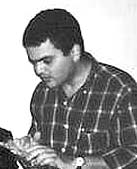 |
|
Ara
Sarafian |
What happened to Ara Sarafian? At one time, he seemed to
wish to concentrate on at least some degree of truth, so uncommon for
genocide-obsessed Armenians. He wrote, "It erodes the credibility of Armenian Genocide
studies and opens people to ridicule when they repeat these claims."
The claims he was referring to? A Blue Book
claim!
Then he had his tangle (read here) with Rouben
Adalian, who (in his "Tendentious Criticism") almost
accused Sarafian of being a sinister Turkish agent. (Just like when the other
Armenian Forum editor, Vincent Lima, dared to go off the genocide track in the
tiniest way, and Levon Marashlian was all over him, implying that maybe Lima was also some kind
of sinister Turkish agent, as well! I guess Vahan Cardashian taught the
Armenians well, when he set an example by rabidly attacking Armenian friends
like missionary James Barton,
the instant they went the slightest bit off-course. These are tactics the
Mafia can envy, to keep their members in line.
At any rate, Adalian offered the following
desperate defense: "The most commonly used reference of documents on the
Armenian Genocide is the Bryce-Toynbee (Blue Book)" Perhaps Mr. Sarafian
got so shook up, he had to make amends by trying to validate this awful
propagandistic work.
|
|
|
| How was
the "Blue Book" put together? |
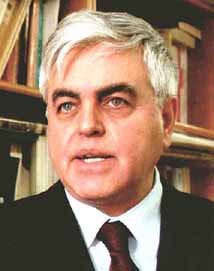 |
|
Prof. Hikmet Özdemir |
Prof. Hikmet Özdemir [Holdwater Note:
There are TWO Prof. Hikmet Ozdemirs in Turkey, as I learned when I put up a photograph of
the wrong one on this page; the one behind this research is connected with the Turkish
Historical Society, or "TTK." The other is connected with the Grand National
Assembly, or "TBMM."] made some discoveries in the British Archives
regarding Wellington House and Toynbee communications, giving a speech on Jan. 2005
explaining his findings. (Some of these documents had already been known in years past.)
I'll touch on a few highlights of the professor's fine research, but mostly it's good to
corroborate just how "in the dark" the Wellington House propagandists were, and
how extensively the "anti-Turkish" community of the period relied upon one
another. (See link at page bottom for excerpts from this speech.)
Let's keep in mind these communications evidently regarded future
blue book editions, after 1916's "The Treatment of Armenians in the Ottoman
Empire, 1915–1916" work; but the methods of operation are the same. In fact, at
page's end, Dr. Barton refers to sources as of Oct. 1915 in his May 1, 1916 letter... no
doubt regarding the sources for the April 1916 "Treatment" work.
In a June 23, 1916 letter, Toynbee freely asked Prof. Margoliouth for a look-see of
proposed Blue Book materials and point out any "glaring mis-statements of fact,"
and freely admits, "My knowledge on the greater part on the ground is very shaky
and second-hand." for a look-see of
proposed Blue Book materials and point out any "glaring mis-statements of fact,"
and freely admits, "My knowledge on the greater part on the ground is very shaky
and second-hand."
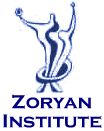 |
|
Zoryan
Institute |
The chief propagandist and "authority" on the
"Armenian Question" is on record for admitting how in the dark he was regarding
the allegations he was freely making. Not that we needed these words to know, but it's
good for Toynbee to have corroborated his ignorance. Particularly since the Zoryan
Institute is still passing off statements such as, "Arnold Toynbee, who in 1916
produced the official and most comprehensive British documentation of the Armenian
genocide." We can see the worth of that documentation.
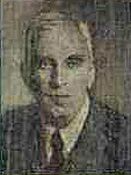 |
|
Arnold
Toynbee |
Prof. Hikmet Özdemir tells us Toynbee lived from 1889 to 1975, and
when listing his books for son Peter, bypassed his work from the war years. This
demonstrates how little he thought of his Blue Book "scholarship." He was quick
to term it as "propaganda" as early as his next legitimate book, 1922's “The
Western Question in Greece and Turkey." (Pg. 50.) In 1957, Toynbee was quoted
again as referring dismissively to his Blue Book work as "war propaganda."
We are told whereas Lord Bryce was an object for hero-worship by Armenians (one named
Hagopian said something to the effect that Bryce's name will be remembered as long as an
Armenian lives, at the time of Bryce's 1922 death), Toynbee was perhaps never given such
reverence.
|
|
Upon the Armenians' 50th Anniversary Commemoration in
1965, an Armenian-American lady named Etmekjian wrote to Toynbee (the contents of
her March 1, 1966 letter are unknown, as is her follow-up) and the two letters
Toynbee wrote in response revealed the historian made no reference to genocide....
although it appeared likely that was the kind of admission the woman was striving
for. The second letter ends with the sentiment human beings should admit to
wrongdoing, but "nationalism is a hindrance to this, unfortunately." The
meat of the first  , dated March 16: , dated March 16:
"It is true that the British Government's motive in asking Lord Bryce to
compile the blue book was propaganda. But Lord Bryce's motive in undertaking it, and
mine in working on it for him, was to make the truth known, and the evidence was
good; the witnesses were all American missionaries with no political axe to grind.
So the Blue Book, together with Lepsius's book, does give a true account.
In 1915 the Russians were invading North-eastern Turkey, and it was reasonable for
the Turkish Government to fear that the Armenian minority there might be a 'fifth
column'. So it would have been legitimate to deport them, as the U.S. Government
deported the Japanese-Americans from the Pacific coast in World War II. But the
deportations of the Armenians in 1915 were used — by the Turkish Government, not
by the people —
as an opportunity for treating the deportees in ways that were so inhuman that
they were bound to cause wholesale mortality, as they did."
If I may take a moment to analyze, it looks like in this period of his life Toynbee
is attempting to legitimize the 1915 events in accordance to his propagandistic
views. (Although, of course, he is sincere in his beliefs. But why is he so
convinced?) In his first paragraph, he admits the purpose of the Blue Book was
"propaganda." While Toynbee probably tried to be as accurate as he could
(instead of just blindly making things up), if one’s purpose is to distort truth,
how could he feel the Blue Book was legitimate?
Particularly if he admits, "the witnesses were all American missionaries
with no political axe to grind." Quite the contrary, the prayers of the
missionaries directly instructed these religious fanatics to make the Turk as
inhuman as possible, breaking the commandment, THOU SHALT NOT BEAR FALSE WITNESS
AGAINST THY NEIGHBOR; it was their "Godly duty" to vilify the Turks. And
far from having no political axe to grind (has Toynbee lost all sense of reality,
here?), the relief organizations became the most successful charitable drive in
American history, raising an amount the equivalent of one billion dollars today,
according to Peter Balakian’s "Burning
Tigris" book. (Although I’ve come across another Balakian source where
the poet claimed $2.5 billion. Ahh, Armenians and their propensity for numbers.) The
most effective way to separate teary-eyed Christian sympathizers from their money
was to claim poor, innocent Christians were being monstrously mistreated by heathen
infidels.
The fact that Toynbee gives credence to mad-dog religious fanatic Vicar Lepsius’ work illustrates how Toynbee’s
deep commitment to his Christian faith has colored his views. We’ll be coming to
that.
|
Here is one indication of
Toynbee's Devotion to Faith:
In "10 Questions for God," #6: Will the
world end? (bigquestions.com/six/page1.htm), Toynbee provides among six symptoms of
a dying society (from his "Study of History"):
(1) sexual 'freedom'
wrecks families (kids lack care & relationship education);
(2) people believe the world is ruled by chance, so nothing they do matters;
(3) religion is watered down;
(4) technical skill outpaces moral and spiritual growth;
(5) real creativity is replaced with ‘moral abandon,’ lack of self-control.
The sixth and only
"non-religious/spiritual" reason given regarded war becoming an obsession.
|
With his second paragraph, it looks
like we have journeyed back in time to the 1916 "Treatment of Armenians" Toynbee
claiming outright there was no Armenian rebellion. The Ottoman government did not act
simply out of “fear” the Armenians would rebel; the rebellion is the entire reason why
what happened to the Armenians took place. Additionally, if Toynbee admitted his Blue Book
evidence derived entirely from American missionaries, how could he then turn around in
this second paragraph and imply it was the intention of the government to purposely
mistreat the Armenians? (That is, "all" of his evidence stemmed from
missionaries. Why should this hearsay constitute factual evidence?) The internal documents
are in agreement that the Ottomans did whatever they could to protect the Armenians.
Certainly things went wrong, as they are bound to, given the colossal operation, without
adequate resources and manpower to implement effectively, and without time to plan
properly because a life-and-death war was raging on all fronts against merciless world
superpowers. Even a modern, wealthy nation like the USA, without pressures and with all
the time in the world to plan, encountered avoidable disasters with their action in Iraq.
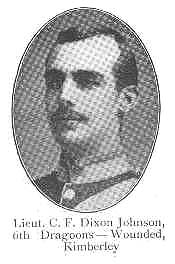 |
|
Boer War
Hero Dixon-Johnson |
Why didn’t Toynbee consult C. F. Dixon-Johnson’s 1916 work,
"The Armenians"? By
courageously daring to go against his nation’s propagandistic demonization policies,
Dixon-Johnson had only the desire to tell the truth as his goal. UPA correspondent Henry
Wood, who seems to have been a genuine eyewitness (in fact, he claims as much, in an Aug.
1915 account that's also mentioned below), flat out reported that the Armenians not only
were in open revolt but were actually in possession of Van and several other important
towns. Wood also stated:
"It appears obvious that the Turkish authorities, anxious for the safety of their
lines of communication, had no other alternative than to order the removal of their
rebellious subjects to some place distant from the seat of hostilities, and their
internment there. The enforcement of this absolutely necessary precaution led to further
risings on the part of the Armenians. The remaining Moslems were almost defenceless,
because the regular garrisons were at the front as well as the greater part of the police
and able-bodied men. Already infuriated at the reports of the atrocities committed at Van
by the insurgents, in fear for their lives and those of their relatives, they were at last
driven by the cumulative effect of these events into panic and retaliation and, as
invariably happens in such cases, the innocent suffered with the guilty."
(I just discovered Wood ironically was one of the sources for
"The Blue Book"! And he's obviously not as forgiving as the Turks in that
passage. How interesting Wood's testimony clearly speaks of the Armenians' rebellion, in a
propaganda book where Toynbee unequivocally tells us there was no Armenian rebellion.
Mostly, Wood describes the heavy-handed way in which Armenians were rounded up, an account
which no doubt has at least some truth. His ending statement is the most damaging in this
Aug. 14, 1915 newspaper account, that one of "the basic principles of the Young Turk
party" is to "ensure the supremacy of the Turkish race in the Ottoman
Empire... absolutely analogous to that which preceded the Armenian massacres under
Abd-ul-Hamid. So far, however, the Young Turks have confined themselves to the new system
of deportation, dispersion and separation of families." So Wood only suspects
attempts at extermination, but clearly reports it hasn't taken place... as late as August,
1915! I suspect the Wood statement in Dixon-Johnson's book came later, after Wood had a
chance to see what was really happening.) This Blue Book-Wood account may be [Read Here].
1. DESPATCH(8) FROM MR.
HENRY WOOD, CORRESPONDENT OF THE AMERICAN "UNITED PRESS" AT CONSTANTINOPLE ;
PUBLISHED IN THE AMERICAN PRESS, 14th AUGUST, 1915.
So critical is the situation that Ambassador
Morgenthau, who alone is fighting to prevent wholesale slaughter, has felt obliged to
ask the co-operation of the Ambassadors of Turkey's two Allies. They have been
successful to the extent of securing definite promises from the leading members of the
Young Turk Government that no orders will be given for massacres. The critical moment
for the Armenians, however, will come, it is feared, when the Turks may meet with
serious reverses in the Dardanelles or when the Armenians themselves, who not only are
in open revolt but are actually in possession of Van and several other important towns,
may meet with fresh successes. It is this uprising of the Armenians who are seeking to
establish an independent government that the Turks declare is alone responsible for the
terrible measures now being taken against them(9). In the meantime, the position of the
Armenians and the system of deportation, dispersion, and extermination that is being
carried out against them beggars all description.
Although the present renewal of the Armenian atrocities has been under way for three
months, it is only just now that reports creeping into Constantinople from the remotest
points of the interior show that absolutely no portion of the Armenian population has
been spared. It now appears that the order for the present cruelties was issued in the
early part of May, and was at once put into execution with all the extreme genius of the
Turkish police system---the one department of government for which the Turks have ever
shown the greatest aptitude, both in organisation and administration. At that time
sealed orders were sent to the police of the entire Empire. These were to be opened on a
specified date that would ensure the orders being in the hands of every department at
the moment they were to be opened. Once opened, they provided for. a simultaneous
descent at practically the same moment on the Armenian population of the entire Empire.
At Broussa, in Asiatic Turkey, the city which it is expected the Turks will select for
their capital in the event of Constantinople falling, I investigated personally the
manner in which these orders were carried out(10). From eye-witnesses in other towns
from the interior I found that the execution of them was everywhere identical. At
midnight, the police authorities swooped down on the homes of all Armenians whose names
had been put on the proscribed list sent out from Constantinople. The men were at once
placed under arrest, and then the houses were searched for papers which might implicate
them either in the present revolutionary movement of the Armenians on the frontier or In
plots against the Government which the Turks declare exist. In this search, carpets were
torn from the floors, draperies stripped from the walls, and even the children turned
out of their beds and cradles in order that the mattresses and coverings might be
searched.
Following this search, the men were then carried away, and at once there began the
carrying out of the system of deportation and dispersion which has been the cruellest
feature of the present anti-Armenian wave. The younger men for the most part were at
once drafted into the Army. On the authority of men whose names would be known in both
America and Europe if I dared mention them, I am told that hundreds if not thousands of
these were sent at once to the front ranks at the Dardanelles, where death in a very
short space of time is almost a certainty. The older men were then deported into the
interior, while the women and children, when not carried off in an opposite direction,
were left to shift for themselves as best they could. The terrible feature of this
deportation up to date is that it has been carried out on such a basis as to render it
practically impossible in thousands of cases that these families can ever again be
reunited. Not only wives and husbands, brothers and sisters, but even mothers and their
little children have been dispersed in such a manner as to preclude practically all I
hope that they will ever see each other again.
In defence of these terrible measures which have been taken, the Turks at Constantinople
declare that no one but the Armenians themselves is to blame. They state that when the
present attack began on the Dardanelles, the Armenians were, notified that if they took
advantage of the moment when the Turks were concentrating every energy for the
maintenance of the Empire, to rise in rebellion, they would be dealt with without
quarter. This warning, however, the Armenians failed to heed. They not only rose in
rebellion, occupying a number of important towns, including Van, but extended important
help to the Russians in the latter's campaign in the Caucasus.(11)
While this is the Turkish side of the situation, there is also another side which I
shall give on the authority of men who have passed practically their entire lives in
Turkey and whose names, if I dared mention them, would be recognised in both Europe and
America as competent authority. According to these men, the decision has gone out from
the Young Turk party that the Armenian population of Turkey must be set back fifty
years. This has been decided upon as necessary in order to ensure the supremacy of the
Turkish race in the Ottoman Empire, which is one of the basic principles of the Young
Turk party. The situation, I am told, is absolutely analogous to that which preceded the
Armenian massacres under Abd-ul-Hamid. So far, however, the Young Turks have confined
themselves to the new system of deportation, dispersion and separation of families..
[Close]
Naturally, Wood is far from the only source turning the claims of the Blue Book on their
ear, for example, acclaimed American academician, Prof. John Dewey, wrote:
Few Americans who mourn, and justly, the miseries of the Armenians, are aware that
till the rise of nationalistic ambitions, beginning with the 'seventies, the Armenians
were the favored portion of the population of Turkey, or that in the Great War, they
traitorously turned Turkish cities over to the Russian invader; that they boasted of
having raised an army of one hundred and fifty thousand men to fight a civil war, and that
they burned at least a hundred Turkish villages and exterminated their population.
When Toynbee was concerned such accounts of Armenian treachery were occasionally
alluded to in the no-longer-as-tightly-controlled post-war press, he wrote in a Sept. 26,
1919 memo (F.O. 371/3404/162647, p. 2):
"To lessen the credit of Armenians is to weaken the anti-Turkish action. It was
difficult to eradicate the conviction that the Turk is a noble being always in trouble.
This situation will revive this conviction and will harm the prestige not only of
Armenians, but of Zionists and Arabs as well.
The treatment of Armenians by the Turks is the biggest asset of his Majesty’s
Government, to solve the Turkish problem in a radical manner, and to have it accepted by
the public."
Suddenly Arnold Toynbee doesn’t strike one as a fellow where truth was his prerogative,
and his statement explaining his motivation “to make the truth known” sounds very
hollow.
FROM
TOYNBEE'S BIOGRAPHER:
"The
British use the Ottoman Armenians against the Polish Jews in the propaganda war. In
the war, Russia massacres the Polish Jews.
And
Germany makes efforts to take the Jewish lobby in the USA to its side with the
publications about this massacre.
In such
a circumstance, Britain charges the Ottoman Empire, who is the ally of Germany, of
conducting a similar massacre, with the aim of disrupting the German propaganda.
Britain wants to prevent the Jewish lobby in the USA from sympathizing with Germany
by propagating the unfounded rhetoric stating that similar incidents do happen in
the Ottoman lands as well.
The
reason of publication of the 'Blue Book' is to make propaganda against Germany.
Finally
in 1917 the USA involves in the war, siding with the Allied States. Namely, Toynbee
does win the propaganda war!"
William
H. McNeill, "Arnold Toynbee - A Life" (1989 ). McNeill was
professor of history emeritus at the University of Chicago, where he taught for 40
years. He further characterizes the Blue Book as "a
disinformation book favoring the Allied states and aiming at shaping the public
opinion, which does not go beyond the obsessive task of humiliating the Turks."
|
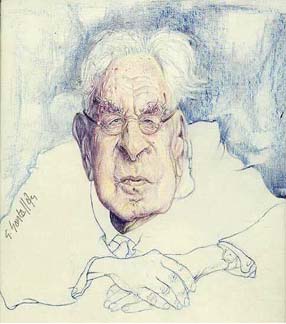 |
|
Arnold
Toynbee, caricatured, his later years |
I haven't read Experiences, a 1969 book
by Toynbee, but Dadrian's Zoryan Institute points out Toynbee has gone back to his
Blue Book roots, using words as "largely successful attempt to
exterminate" to describe the Ottoman Turks' actions. Prof. Hikmet Özdemir
tells us Dadrian claims to have written to Toynbee, and Toynbee apparently flat out
spoke in genocidal terms that no doubt made the Armenian prosecutor giddy with
delight. The Turkish professor is maintaining a professional level of respect toward
Dadrian, but anyone who knows Dadrian is aware his word can be taken as far as can
be thrown, when regarding this genocide obsession. Ozdemir wonders why Dadrian
hasn't made this letter public. It's a good question; the Toynbee letter would have
provided good ammunition for Dadrian's cause. (Not that it's entirely necessary,
because other damning Toynbee statements have been rounded up... in Toynbee's
penultimate work, "Acquaintances," as well. Still, every little bit of
dirt helps, for the Dadrians of the world.) Perhaps, like Aram Andonian (of Talat
Pasha telegrams fame), Dadrian might have "lost" the original.
Prof. Hikmet Özdemir reveals some interesting facts about Toynbee during his
"pro-Turk" period. After his first 1912 visit, where he seems to have
hated the land, his eyes kept opening during visits in 1921, 1923, 1929, 1948 1962,
and finally 1968.
In 1948, his "pal," Turkish leader Ismet Inonu, ordered Toynbee's
"Study of History." In a letter dated Nov. 23, 1948 to son Omer, Inonu
wrote that he had met with Toynbee, and described the historian as too much of a
Christian and somewhat of a religious fanatic. (The Turkish words: "Fazla
Hristiyan" and "dinci.") Another friend, "liberal" writer
Ahmet Emin Yalman, independently corroborated this Toynbee characteristic in 1952.
Prof. Özdemir informs us that in August 1914 some of Britain's luminaries and
historians gathered and declared the first thing they needed to do in order to win
the war at hand was to get the USA to join. They planned on opening a propaganda
division with this goal in mind. The historians were told their duties would consist
of writing books, preparing brochures, lobbying newspapers like "The New York
Times," and all the news articles, photographs and the works would henceforth
be prepared. This movement would grow to be known as "Wellington House."
Interestingly, a number of the documents in the British Archives are forbidden. Some
are deemed never to be opened, while others are time-stamped: to be opened in 2015,
2020 and so forth.
|
| |
The Turkish professor also tells us after the USA
hooked up in the First World War, they learned soon after that they were taken for a
ride by British propaganda. With Britain in the role of The Boy Who Cried Wolf, the
Americans took their time before coming to the rescue in W.W.II.
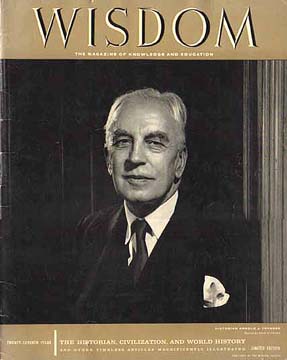 |
|
Toynbee
featured in the cover of the Sept. 1958
issue of Wisdom (Vol. 3, No.27), in apainting
by Yousuf Karsh |
In June 15, 1916, Toynbee wrote Boston's Dr.
Barton a letter  ,
saying the missionary Rockwell turned down Toynbee's request for names connected
with "Mrs. Christie's journal of events at Tarsus," as the
information belonged to Barton. Toynbee asks Barton of the same, and additionally
requests the missionary to "fill in confidentially any further gaps in my
collection." ,
saying the missionary Rockwell turned down Toynbee's request for names connected
with "Mrs. Christie's journal of events at Tarsus," as the
information belonged to Barton. Toynbee asks Barton of the same, and additionally
requests the missionary to "fill in confidentially any further gaps in my
collection."
"It, of course, weakens very much my position in editing these documents if
I cannot say in the preface that I am personally in possession of the names of the
people and places concerned."
Toynbee badgers Boston's Dr. Rockwell with another letter on June 20th, pretty much
saying the same. He adds, "If I have to admit in a certain number of cases
that the names are actually unknown to me, this will have a very weakening effect on
the body of the evidence."
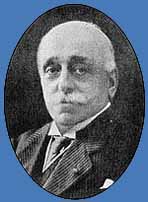 |
|
Boghos
Nubar |
Toynbee also hobnobs with Boghos Nubar in a June 20 letter  (along with
Switzerland's Leopold Favre in a separate letter dated June 20), asking the Armenian
leader for any "suggestions or corrections." Yes, it's sources like
Nubar that helped make Toynbee's work "the official and most comprehensive
British documentation," as the Zoryan Institute still tries to sell us.
Toynbee lets Nubar know documents will be sent, "the authorship of which is
still unknown to me." (along with
Switzerland's Leopold Favre in a separate letter dated June 20), asking the Armenian
leader for any "suggestions or corrections." Yes, it's sources like
Nubar that helped make Toynbee's work "the official and most comprehensive
British documentation," as the Zoryan Institute still tries to sell us.
Toynbee lets Nubar know documents will be sent, "the authorship of which is
still unknown to me."
"Of course, I would keep any further names you revealed to me as
confidential."
Is this the kind of source Ara Sarafian possibly researched in an attempt to
validate the Blue Book? Are we supposed to accept the word of Boghos Nubar, or for
that matter, Turk-vilifying missionaries? Even if Sarafian pinned down some of these
names... and how he could have done so is another matter, since even the principals
from the period were having trouble making I.D.s of all the hearsay... what
difference does it make? These conflicted sources could have made up any phony name,
like "Emile Hilderbrand."
Toynbee was persistent, but for all his efforts to pin down the names, Dr. Barton
had already written the young propagandist-historian on May 1, 1916  : :
"I very much regret that we are unable to fill in the blanks in the
documents that our Committee published in galley form for the press under date of
October 14 1915. Most of these documents are not now here; in fact, many of them are
not now accessible to us. I doubt if the names of the places would be especially
significant."
"In Mrs. Christie's notes, the names have not been furnished to us."
|
| |
Professor Justin McCarthy says, in his excellent
overview of the insidious doings, behind-the-scenes:
The Wellington House brief was
simple, the same brief as that of all propagandists. They were to make the enemies look as
bad as possible and make their friends, and especially the British themselves, look as
good as could be. Their main focus was, naturally, Germany, but much effort was expended
against the Turks. Propaganda was not considered to be a gentleman's game. Toynbee himself
remarked that he would like to get out of it for that reason. Nevertheless it was
something that had to be done and British gentlemen did it. They were probably always
ashamed of their work, however, as indicated by the fact that they destroyed all the
records of the Propaganda Office immediately after the war.
Of further interest: War-time
disinformation and "The Blue Book"
Chart
Depicting Wellington House's Reach
|
|